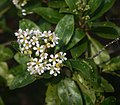Escallonia
| Escallonia | ||||||||||||
|---|---|---|---|---|---|---|---|---|---|---|---|---|

Escallonia rubra var. Macrantha |
||||||||||||
| Systematics | ||||||||||||
|
||||||||||||
| Scientific name | ||||||||||||
| Escallonia | ||||||||||||
| Mutis ex L. f. |
Escallonia is a genus of plants inthe Escalloniaceae family . The approximately 147 Escallonia - species come to the Andes in South America before. The generic name honors the Spanish doctor and researcher Antonio Escallón (José Antonio Escallón y Flórez) (1739 - 1819).
description

Vegetative characteristics
The Escallonia species grow as evergreen shrubs or trees and reach heights of up to 10 meters. The smooth, leathery, undivided leaves are serrated or have entire margins and are alternate.
Generative characteristics
The flowers are arranged in paniculate inflorescences .
The hermaphroditic flowers are radial symmetry and five-fold with a double flower envelope . The five durable sepals are more or less fused. The five free petals are usually much longer than the sepals. There is only one circle with five free stamens that are about as long as the sepals. Two or three carpels are one under constant ovary grown. The cylindrical style ends in a cephalic scar.
Two-, four- or three-, sixfold capsule fruits are formed.
Ecological importance and endangerment
Some Escallonia species make up an essential part of the natural vegetation of the Andes, in Peru in particular Escallonia resinosa (chachakuma) and Escallonia myrtilloides (t'asta) . Their stocks are threatened by overgrazing and excessive use for firewood.
Systematics
The genus Escallonia was founded in 1781 by the botanist José Celestino Mutis with the type species Escallonia myrtilloides in Carl Linné the younger Supplementum plantarum systematis vegetabilium editionis decimae tertiae, generum plantarum editionis sextae, et specierum plantarum editionis secundae. Brunsviga set up. The genus Stereoxylon described by Hipólito Ruiz López and José Antonio Pavón y Jiménez in 1798 is a synonym; the stereoxylon species described in the same place were placed by Christiaan Hendrik Persoon in 1805 as part of the genus Escallonia . Stereoxylon patens Ruiz & Pav. Is a synonym of Escallonia myrtilloides Mutis ex L. f. Ruiz and Pavón also point to this synonymy in 1798.
The genus Escallonia comprises around 147 species , including (selection):
- Escallonia herrerae Mattf. : It occurs in Peru.
- Escallonia illinita C. Presl : It occurs in Chile.
- Escallonia laevis (Vell.) Sleumer : It occurs in Brazil.
- Escallonia poasana Thursday . Sm . : It occurs in Costa Rica and Panama.
- Escallonia resinosa (Ruiz & Pav.) Pers. , in Quechua chachakuma or urqu chachakuma , in Peru .
- Escallonia myrtilloides Mutis ex L. f. , in Quechua t'asta , from Venezuela to Bolivia .
- Escallonia rubra (Ruiz & Pav.) Pers. : It occurs in Chile .
- Escallonia virgata (Ruiz & Pav.) Pers. : It occurs in Chile.
photos
Individual evidence
- ↑ Lotte Burkhardt: Directory of eponymous plant names . Extended Edition. Botanic Garden and Botanical Museum Berlin, Free University Berlin Berlin 2018. [1]
- ^ J. Francis McBride: Flora of Peru , 1935, p. 1025.
- ↑ a b Systema vegetabilium florae peruvianae et chilensis , anno 1798, auctoribus Hippolyto Ruiz et Josepho Pavon. Tomus primus. Pagina 66.
- ^ Daniel W. Gade (1999): Nature and culture in the Andes. Pp. 42-48: Deforestation and reforestation of the central andean highlands.
- ^ Escallonia at Tropicos.org. Missouri Botanical Garden, St. Louis, Retrieved April 17, 2018.
- ↑ Christiaan Hendrik Persoon: Synopsis plantarum. Pars great. Parisii Lutetiorum , 1805, p. 234, n.522 . Escallonia .
- ↑ a b c d e f Escallonia in the Germplasm Resources Information Network (GRIN), USDA , ARS , National Genetic Resources Program. National Germplasm Resources Laboratory, Beltsville, Maryland. Retrieved February 1, 2019.
Web links
- Data sheet from Flora Brasiliensis
- Illustration by Escallonia at DELTA.
- Genus of the Escalloniaceae family at DELTA by L. Watson & MJ Dallwitz.
Historical literature
- Robert Brown in Barthélemy Charles Joseph Dumortier : Analysis des familles des plantes: avec l'indication des principaux genres qui s'y rattachent , 1829, pp. 35, 37.





